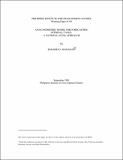| dc.contributor.author | Manasan, Rosario G. | |
| dc.date.accessioned | 2014-03-07T16:42:16Z | |
| dc.date.available | 2014-03-07T16:42:16Z | |
| dc.date.issued | 1981-09 | |
| dc.identifier.citation | Manasan, R.G. (1981) An econometric model for forecasting internal taxes: A national level approach. PIDS working paper, 8108. Manila: PIDS. | en_GB |
| dc.identifier.uri | https://opendocs.ids.ac.uk/opendocs/handle/20.500.12413/3593 | |
| dc.description.abstract | The ability to project and forecast future tax collections is an important element in
the identification of future budgetary gaps and the planning of new tax measures that may
be needed to meet these needs. Aside from projecting future tax collections, a good tax
forecasting model may also be used as a gauge against which to measure the
government’s tax collection efforts.
The purpose of this paper is to develop, specify and estimate a forecasting model
for internal taxes which has a higher level of disaggregation, includes determinants in the
specification other than tax bases, and considers various proxy variables for the tax bases.
Total tax collections fall into four general categories, namely: (1) income taxes,
(2) license and business taxes, (3) specific taxes, and (4) other taxes. Some seventy subcategories
are divided into these four main groupings.
Structural single equation forecasting models were specified and estimated for a
selected number of these sub-categories for the period 1961-1978. The rest were
estimated through the use of identities.
The determinants used to explain and forecast the movements of the tax variables
may be classified into two groupings: (1) variables that reflect the tax bases; and (2)
variables that reflect the changes in the tax structure and tax rates over time.
In specifying the functional relationship between the tax and explanatory
variables, both the linear and logarithmic forms wee considered. For each of the
forecasting equations estimated, the t-statistics, coefficient of determination, R2, and the
percentage root mean square error (RMSE%) were computed to aid in evaluating the relative merits of alternative forecasting equations. The equation harnessing the highest
number of merits relative to a set of criteria is used to compute the forward projections of
the tax variable specified.
Having built an econometric model for forecasting future taxes which exhibited
lower forecasting errors, were now challenged to test our next modeling work towards the spatial or regional direction.
The full documentation of this project required the inclusion of the data base of
the tax variables and their determinants for the estimating (1961-1978) and forecasting
(1979-1982) period. Since the data series for these highly disaggregated variables were
not readily available, this was an initial problem. The result of the effort, though, should
eliminate re-gathering of data already established and make the model implementable by Bureau personnel. | en_GB |
| dc.language.iso | en | en_GB |
| dc.publisher | Philippine Institute for Development Studies | en_GB |
| dc.relation.ispartofseries | PIDS working paper series;8108 | |
| dc.rights.uri | http://creativecommons.org/licenses/by-nc-nd/3.0/ | en_GB |
| dc.subject | Development Policy | en_GB |
| dc.subject | Governance | en_GB |
| dc.title | An econometric model for forecasting internal taxes: A national level approach | en_GB |
| dc.type | Series paper (non-IDS) | en_GB |
| dc.rights.holder | Philippine Institute for Development Studies | en_GB |


